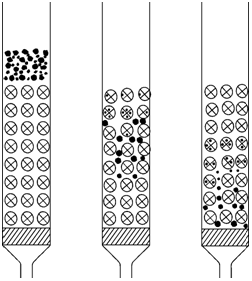Basic Principle:
The packagings for size exclusion chromatography generally consist of cross connected polymers of polyacrylamides, dextrans, silica or styrene. Those have an open network. On absorbing the solvent, swelling causes an opening of the structure. The degree of cross linking will determine the size of the holes.
In this network of uniform pores, the solute and solvent molecules could diffuse. Although within the pores, molecules are effectively trapped and erased from the flow of the mobile phase. An average residence time of the solute molecules depends upon their effective size. The molecules that are significantly bigger than the average pore size are excluded.
As a output of this, they suffer no retention and travel by the column at the rate of mobile phase. The molecules which are appreciably smaller than the pore size could penetrate throughout pore network and, therefore, remain entrapped for the longest time.
As an output of this, the molecules that are able to penetrate the gel will spend part of their time sheltered from the moving phase.
Among these two extremes are intermediate size molecules whose average penetration within the pores of packing depends upon their diameters. Fractionation within this group is directly associated to the molecular size and, to some extent, molecular shape.
Thus, there is a basis of separating molecules of different sizes. Figure shows schematically three stages in the chromatographic separation of two extreme sizes of molecules.

Figure: Schematic of a chromatographic separation on a size exclusion column. Large open crossed circles represent the stationary phase; large black circles represent molecules which do not penetrate K = 0; smaller black circles represent molecules which penetrate the gel and are retarded in their movement down the column.
It is important to note that size exlusions are different from other chromatographic procedures. Here, there are no physical or chemical interactions between the analyte and the stationary phase. Since a matter of fact, efforts are made to avoid such interactions because they may cause impaired column efficiencies. At this point, it may be important to introduce the term exclusion limit. The exclusion limit is the molecular weight of that molecule that will just permeate the gel and be retarded. This can range from 1000 to several millions depending upon the gel. It should be kept in mind that separation is based on molecular size and configuration rather than simply its molecular weight but, commonly, there is a correlation along with molecular weight. Also, generally the molecules smaller than the exclusion limit can be fractionated down to a limiting size.